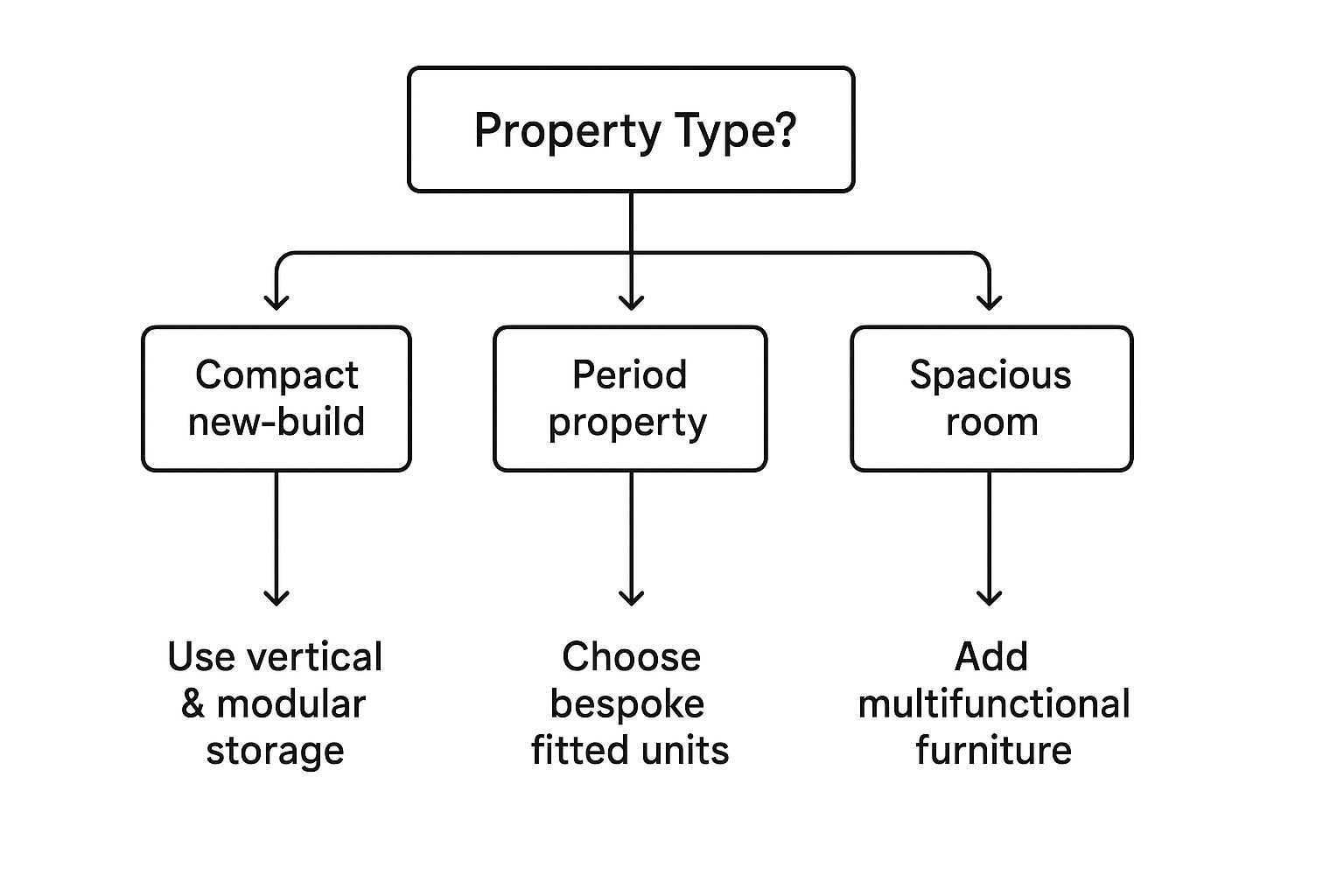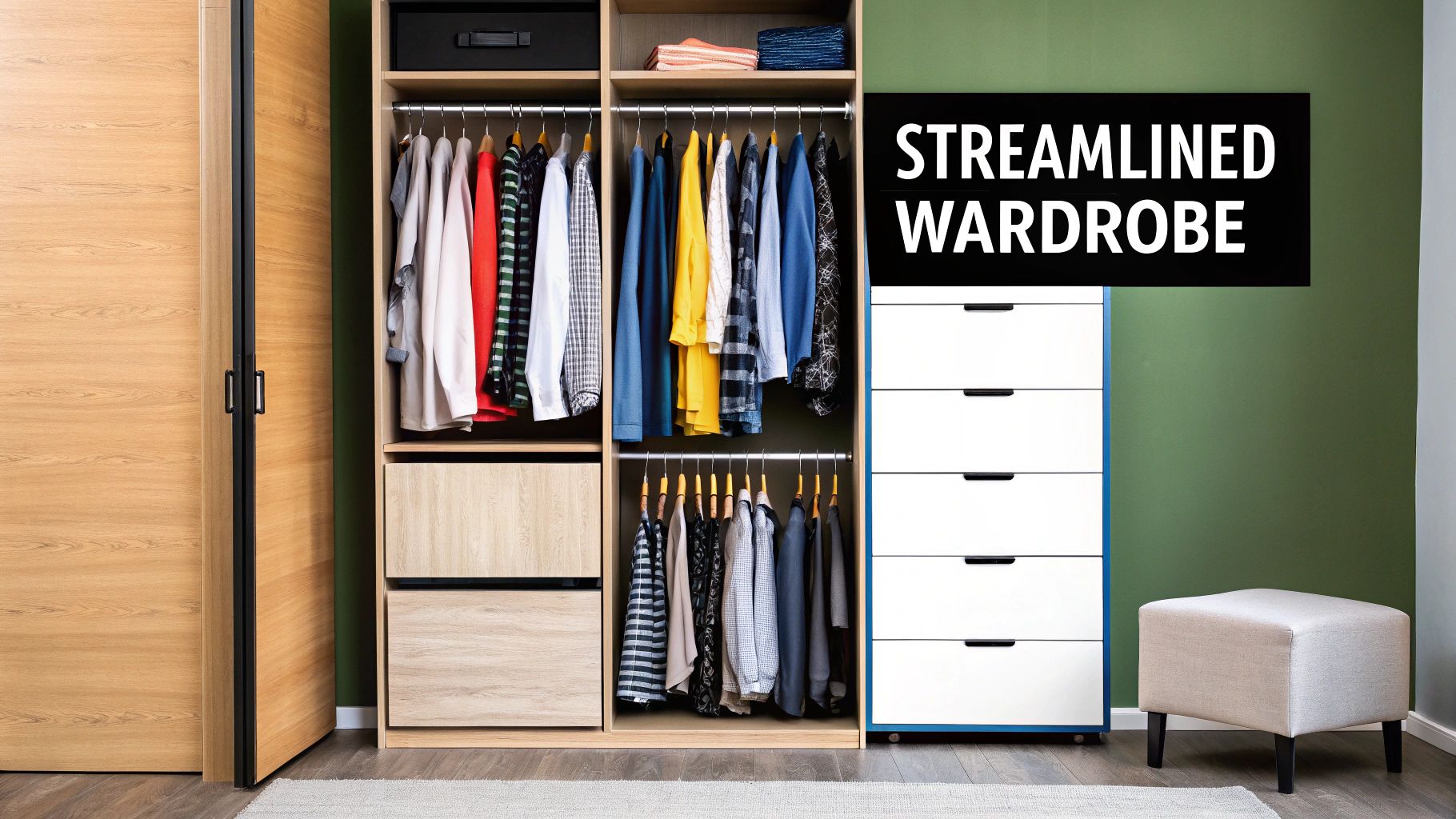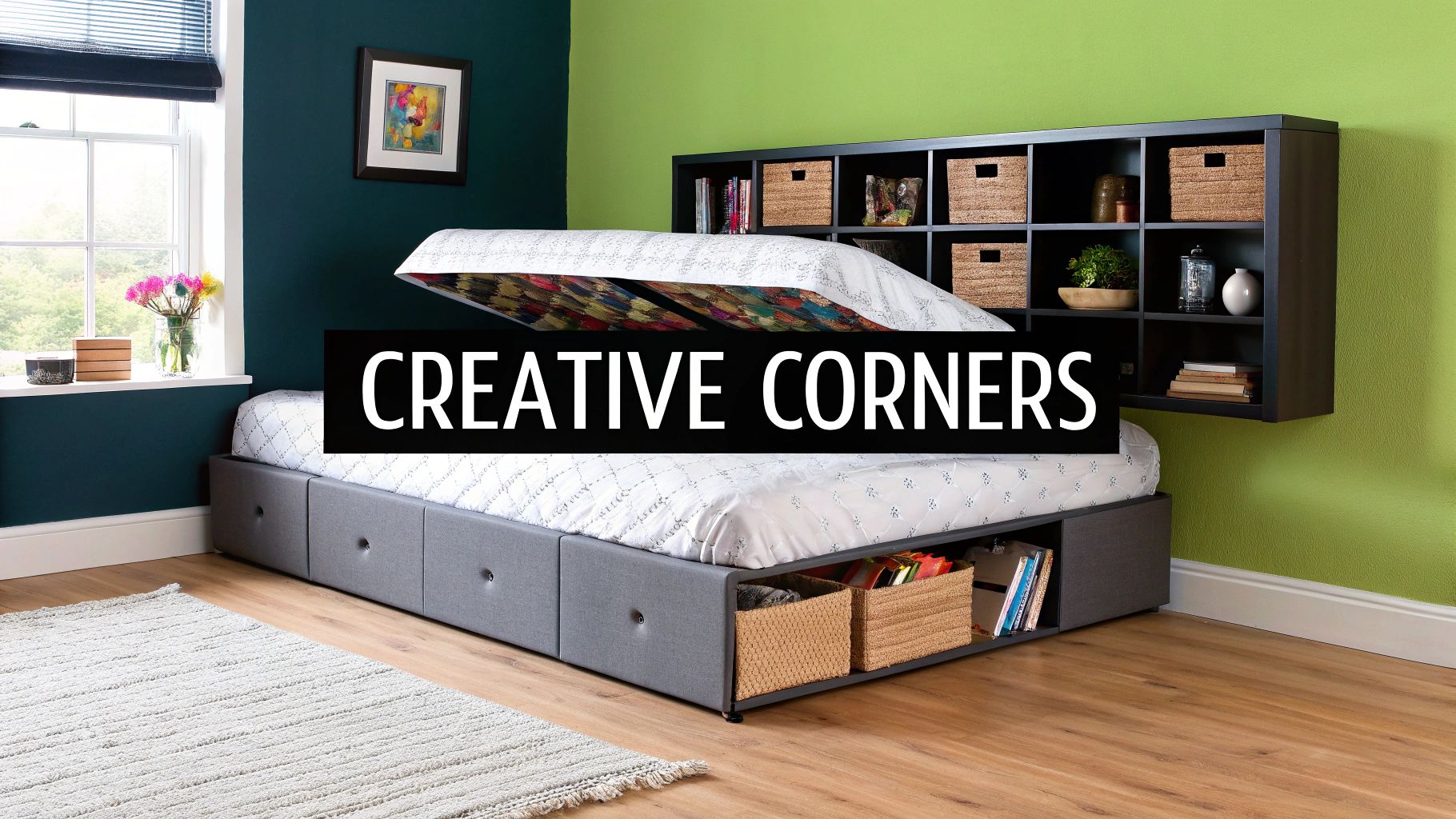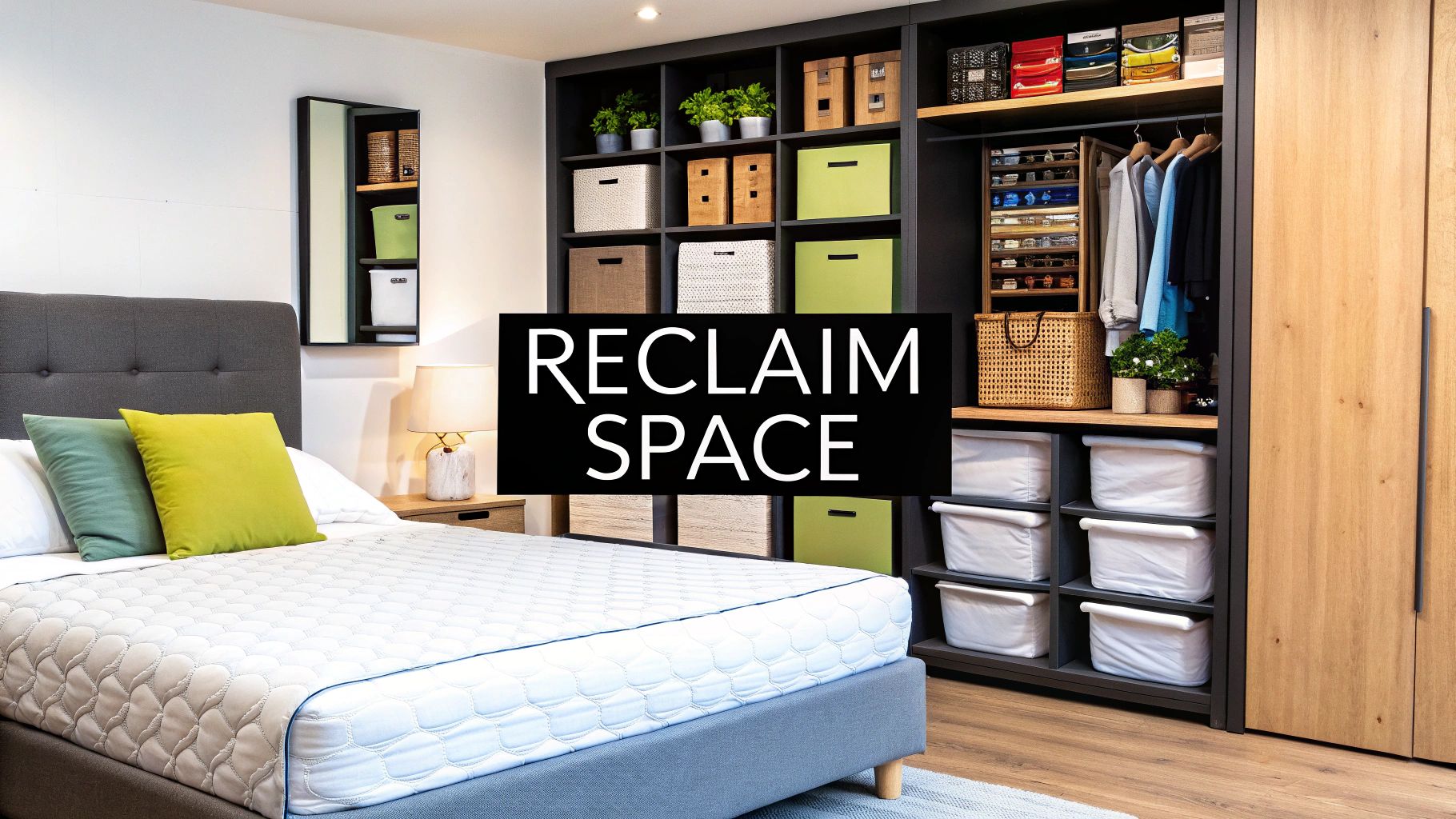Good bedroom storage solutions do more than just tidy up your room. They help create a calm, practical space where everything, from your favourite jumper to your treasured keepsakes, has a proper home. It is all about turning your bedroom from a source of stress into a peaceful place for rest and relaxation. A well organised space is not just neat, it is essential for a peaceful mind.
Finding Calm in the Clutter
It is hard to feel truly rested when you are surrounded by piles of clothes, overflowing drawers, and general disarray. A cluttered bedroom often leads to a cluttered mind. But getting your storage right is about so much more than hiding things away. It is about creating a peaceful, useful, and deeply restful environment that genuinely supports your wellbeing.
Try to see storage as an opportunity rather than a chore. This simple change in outlook can make all the difference. Instead of seeing a messy room as a problem, look at it as a blank canvas, a chance to design a space that works perfectly for you and your daily routine. Suddenly, the process feels creative and rewarding.
Why a Tidy Bedroom Matters
A well organised bedroom can have a surprisingly powerful impact on your life. When everything has its place, your daily routines become smoother, from getting ready in the morning to winding down at night. That sense of order can significantly reduce stress and even help you sleep better.
Here is what you stand to gain:
- Feel Less Stressed: A tidy environment helps to calm your mind, making it far easier to relax.
- Save Time: Finding what you need quickly saves time and removes a common source of daily frustration.
- Sleep Better: A calm and uncluttered space is simply more inviting for restful sleep.
- Show Off Your Style: Good storage is a key part of beautiful bedroom decor ideas, allowing your personal style to shine through without being overshadowed by mess.
Tackling UK Home Storage Challenges
Many of us in the UK face unique storage challenges, from the compact layouts of modern new builds to the quirky nooks and alcoves you find in period properties. Each type of home requires a slightly different approach to make the most of its potential.
Thinking about your property type is a brilliant first step in choosing the right bedroom storage solutions. This decision tree shows how different homes can benefit from specific strategies.

The main takeaway here is to let your home’s architecture guide your storage choices. This ensures you select furniture and systems that fit seamlessly into your space. For instance, bespoke fitted units are perfect for older homes with uneven walls, while modular systems offer fantastic flexibility for smaller, modern rooms.
Making the Most of Your Wardrobe Space
The wardrobe is usually the biggest piece of furniture in the bedroom, but is it really working as hard as it could be? A well organised wardrobe can completely change your morning, transforming a frantic search for an outfit into a calm, easy start to the day. It is the heart of your clothing storage, and getting it right is one of the most effective things you can do to declutter your room.
This is not about following a rigid formula. It is about creating a system that works for you. By thinking cleverly about everything from the hangers you use to the internal organisers you choose, you can build a space that does not just hold your clothes, but makes them easy to find and manage.

Start with the Doors
It might sound obvious, but the type of doors on your wardrobe can have a massive effect on your room’s layout and overall feel. Traditional hinged doors are common, but they need a good amount of clear floor space to swing open. In a smaller bedroom, this can make the room feel cramped and seriously limit where you can place other furniture.
Sliding doors, however, are a brilliant alternative. They glide neatly from side to side, so they do not eat into your precious floor space. This small change gives you so much more freedom with your room layout and helps create a cleaner, more modern look. It is clear that people's preferences are shifting towards these kinds of practical, space saving designs. In fact, nearly 60% of UK households have bought new bedroom furniture in the last three years, with many favouring items like wardrobes with sliding doors. You can find out more about these market trends to see how modern design is evolving.
Go Vertical: Use Every Inch Inside
Most wardrobes come with a basic setup, one hanging rail and a high shelf. This often leaves a huge, gaping area of wasted space. The secret to making the most of your storage is to think vertically. By layering your storage, you can dramatically increase what your wardrobe can hold.
Here are a few simple additions that make a world of difference:
- Double Hanging Rails: If you have the height, install a second rail below the main one. It is perfect for shorter items like shirts, skirts, and trousers folded over a hanger. You have just doubled your hanging space.
- Hanging Shelves: Those fabric organisers that hang from the rail are fantastic for folded clothes like jumpers and T-shirts. They prevent piles from toppling over and keep everything visible.
- Stackable Boxes: Use clear, stackable boxes on the top shelf for things you do not need every day, like seasonal clothes or special occasion wear. Being able to see what is inside means you will not have to pull everything down just to find one item.
A Quick Tip: I always tell clients to keep their most used items at eye level. It makes them effortless to grab and, more importantly, to put away. This is the key to maintaining an organised system long term.
The Underestimated Power of Good Hangers
It feels like such a small detail, but believe me, switching your hangers can be a total game changer. A chaotic mix of bulky plastic and wire hangers takes up far more room than you realise and just looks messy.
I highly recommend slimline velvet hangers. Their non slip surface is great for keeping silky tops and wide neck jumpers in place, and their slender profile can genuinely free up a surprising amount of rail space. This one simple swap creates a tidy, uniform look that makes browsing your clothes a much more enjoyable experience.
Before you buy a new wardrobe, it is worth considering which type will best suit your needs.
Choosing the Right Wardrobe for Your Space
This table compares a few common wardrobe types to help you decide which is the best fit for your room size, storage needs, and personal style.
| Wardrobe Type | Best For | Space Consideration | Typical Features |
|---|---|---|---|
| Freestanding | Renters or those who like to rearrange furniture. | Requires ample floor space and clearance for hinged doors. | Often comes as a single unit with a rail and a top shelf. |
| Fitted/Built-in | Maximising storage in oddly shaped rooms or alcoves. | A permanent installation, less flexible but uses space perfectly. | Customisable interiors with rails, shelves, and drawers. |
| Sliding Door | Small bedrooms where floor space is limited. | Does not need swing space for doors, but one side is always covered. | Sleek, modern look, often available with mirrored doors. |
| Modular System | Evolving storage needs and a desire for customisation. | Can be built to fit the space, can feel less 'solid' than fitted. | Comprises separate units (rails, drawers, shelves) you can combine. |
Ultimately, the best wardrobe is one that fits your space and your lifestyle, so take a moment to think about what you truly need before making a decision.
Integrate Drawers and Dividers
Let's be honest, not everything can or should be hung up. Smaller items like socks, underwear, and accessories are notorious for becoming a jumbled mess. This is where drawers and dividers become your best friends.
If your current wardrobe does not have built in drawers, you can often add a small, freestanding chest of drawers inside. Just pop it on the floor of the wardrobe to create a dedicated home for folded items. If you do have drawers, invest in some simple dividers. They create neat little compartments for everything, meaning you will never have to rummage for a matching pair of socks again.
Putting these ideas into practice can turn your wardrobe from a source of stress into a cornerstone of an organised, calm bedroom. It does not take a huge effort, just a bit of thought and a few clever additions can make all the difference.
Beyond the Wardrobe: Creative Storage for Every Corner
A well organised wardrobe is a fantastic starting point, but creating true bedroom harmony means getting creative with every part of your room. It is amazing how much untapped potential is hiding in plain sight, from the vast space under your bed to those empty walls. These often overlooked areas are your secret weapons in the quest for a calm, tidy sanctuary.
The best storage solutions go far beyond a simple chest of drawers. By choosing smart, multi functional furniture and using your space creatively, you can introduce valuable storage that genuinely enhances the style and comfort of your room. It is all about finding pieces that work hard without making the space feel cluttered.

Choose Furniture That Does More
The easiest way to add storage without adding clutter is to pick furniture that serves two purposes. This approach is a lifesaver in any bedroom, but it is a real game changer in smaller spaces where every square inch is precious.
A perfect example is the ottoman bed. On the surface, it is just a stylish bed frame. But lift the mattress base, and you will find a massive hidden storage compartment underneath. It is the ideal place to tuck away bulky items like spare bedding, extra pillows, or seasonal clothing, keeping them dust free and completely out of sight. You get all the comfort of a great bed with the storage capacity of a large chest, all within the same footprint.
Do not forget your bedside tables, either. They are more than just a spot for a lamp and a book. Opting for designs with deep drawers or shelves creates a handy home for all your nighttime essentials, keeping the surface clear and serene. It is a simple swap that helps you maintain that tidy, restful feeling right where you need it most.
Maximise Your Vertical Space
When floor space is limited, the only way to go is up. Using your walls for storage is one of the most effective tricks in the book, as it draws the eye upward and can make a room feel taller and more open.
Here are a few ideas I have seen work brilliantly:
- Floating Shelves: These are fantastic for displaying books, plants, and your favourite decorative pieces without the visual weight of a traditional bookcase. When arranged thoughtfully, they inject personality and style while freeing up the floor.
- Tallboys: A tallboy, or a tall chest of drawers, is a classic for a reason. It offers a generous amount of storage on a very small footprint, making it perfect for those tight corners or narrow alcoves.
- Wall Mounted Units: If you need enclosed storage, consider small, wall mounted cabinets. They provide a sleek, modern look and keep items neatly tucked away without taking up any floor space.
By thinking vertically, you reclaim valuable floor area, which is essential for creating a sense of spaciousness. It is a simple shift in perspective that unlocks a huge amount of previously unused storage potential.
The Power of Under Bed Storage
The space under your bed is prime storage real estate that so often goes to waste. If an ottoman bed is not for you, you can still make brilliant use of this area with dedicated under bed storage boxes.
Look for containers with lids to protect your belongings from dust. I have found that ones with wheels are also incredibly helpful, allowing you to slide them in and out with ease. This is the perfect spot for things you do not need every day, such as:
- Guest bedding and towels
- Out of season shoes and boots
- Sentimental items or photo albums
This strategy is particularly popular in the UK, where homes can often be more compact. The demand for clever, space saving options is reflected in the growing European home storage market. In fact, the UK accounts for about 13.12% of this market, which was recently valued at approximately USD 8.95 billion. Modular units are the fastest growing segment, showing just how much we value adaptable bedroom storage solutions.
Finding the right balance with these furniture pieces is key to a useful and beautiful room. Placing furniture thoughtfully ensures good flow and makes the most of both style and practicality. If you are unsure where to begin, our guide on how to arrange bedroom furniture offers practical tips for creating a layout that feels just right.
Ultimately, by looking beyond the wardrobe, you can transform your bedroom into a beautifully organised and deeply relaxing space. Every corner becomes an opportunity for storage that is both practical and stylish.
Decluttering and Organising Your Belongings
Even with the perfect storage furniture, the real magic happens when you know how to use it. Learning how to declutter and organise what you own is the key that unlocks a truly peaceful bedroom. This is the hands on part, where we shift from simply buying furniture to creating lasting habits that keep your room feeling calm and tidy for good.
This is not about a stressful, one off clear out that leaves you exhausted. It is about adopting a gentler approach to sorting through your things, building a system that feels natural and, most importantly, is easy to maintain.
The Four Box Method Made Simple
Facing a mountain of stuff can feel overwhelming, so it helps to have a clear plan. The 'four box' method is a tried and tested way to make decisions without all the usual stress. Just grab four boxes or bags and give each one a clear label.
This simple system breaks a huge job down into small, manageable decisions. It turns a daunting task into a series of straightforward choices, and you will be surprised how quickly you can make progress.
Here is how it works:
- Keep: For items you genuinely love, use regularly, and that have a definite home in your bedroom. Be honest with yourself. If it does not bring you joy or serve a real purpose, it probably does not belong here.
- Donate: For good quality items you no longer need. Think clothes you have not worn in over a year, books you have read, or decor that no longer fits your style.
- Store: This box is for sentimental items you cannot bear to part with or seasonal things like thick winter jumpers. These will be packed away neatly, maybe in under bed boxes or on a high shelf.
- Bin: For anything broken, worn out, or simply unusable. Do not be afraid to let these things go.
Smart Principles for Lasting Order
Once you have decided what to keep, the next step is to organise it all thoughtfully. The goal is to create a system so simple that tidying up becomes second nature, almost effortless. When everything has a logical place, you spend less time searching for things and more time enjoying your calm space.
Grouping similar items together is the foundation of good organisation. Keep all your socks in one drawer, your t-shirts in another, and your books on a designated shelf. It sounds almost too basic, but this simple rule makes a massive difference to your daily routine.
A well organised bedroom is not just about looks, it has a direct impact on your wellbeing. A clutter free environment can significantly reduce feelings of stress and anxiety, creating the perfect setting for rest. In fact, a tidy room is a crucial part of developing good sleep hygiene and ensuring you get a truly restorative night's sleep.
Mastering the Details
It is often the small things that create the most visual clutter. Tangled jewellery, stray hair accessories, or that one charging cable you can never seem to find when you need it. This is where clever little organisers come into their own.
Drawer dividers are an absolute game changer. Use them inside your bedside table or chest of drawers to create dedicated compartments for everything from underwear and socks to cosmetics. Suddenly, everything has its own little home, and your drawers stay tidy.
For items you are putting into longer term storage, labelling is essential. Use a clear marker to write the contents on the outside of every box. It is a simple, two minute job that will save you hours of rummaging later when you are looking for your winter boots or spare bedding. By focusing on these small but effective habits, you ensure your bedroom remains a sanctuary of calm.
Smart Solutions for Small or Awkward Bedrooms
Let's be honest, not every bedroom is a perfect, spacious rectangle. Many of us are working with charming but challenging spaces, from tiny box rooms and narrow layouts to attic rooms with beautifully sloped ceilings. These quirks do not have to be a storage nightmare. In fact, they are an invitation to get clever.
With a little smart thinking, an awkward room can become a cosy and incredibly useful retreat. It is all about choosing pieces that fit the space, both physically and visually, and turning potential problems into stylish features. A well thought out approach can make even the most difficult layout feel calm and organised.

Embrace Vertical Space
When floor space is limited, the only way to go is up. Using vertical storage is a classic interior design trick that not only makes the most of your capacity but also draws the eye upward, creating an illusion of height that makes the room feel larger.
This does not mean you need to install towering, bulky furniture. Instead, think about slender, elegant pieces that make the most of your wall height without overwhelming the room. Tall, narrow bookcases or ladder style shelving units are perfect for this, offering plenty of space for books and baskets while maintaining a light, airy feel.
This strategy is especially useful when you are working with a smaller flat where every centimetre counts. For more great ideas, our guide to apartment bedroom decorating ideas has plenty of tips for compact living.
Lighten Up with Colour and Clever Design
The furniture you choose has a massive impact on how spacious a room feels. In a small or oddly shaped bedroom, dark, heavy furniture can feel imposing and shrink the space visually. On the other hand, light coloured pieces in shades of white, cream, or pale wood can work wonders.
These lighter colours reflect more light around the room, creating a brighter, more open atmosphere. It is also wise to choose furniture with a smaller visual footprint. Look for pieces with slim legs that lift them off the floor, as seeing the floor underneath creates an immediate sense of spaciousness. A bed frame with a low headboard or a chest of drawers on raised feet will feel much less dominant than solid, blocky alternatives.
The goal is to make your storage feel integrated and seamless, not like it is crowding you out. Choosing furniture that is visually light is just as important as choosing pieces that are physically compact.
Modular Furniture for Tricky Corners
Awkward corners, alcoves, and sloped ceilings are where modular furniture truly shines. Because modular systems are made of individual components, you can mix and match them to create a customised setup that fits your exact space and needs. This flexibility is a huge advantage over standard, one size fits all furniture.
Imagine building a storage unit that fits perfectly under a sloping roof or fills an unusual alcove from wall to wall. Modular systems allow you to do just that, combining hanging rails, shelves, and drawers to create a bespoke solution without the bespoke price tag. This adaptability makes it one of the most practical solutions for non standard rooms.
The need for such adaptable storage is growing, particularly as homes in many parts of the UK get smaller. This trend is indirectly reflected in the growth of the UK self storage sector, which has expanded to 64.3 million square feet as people look for extra space beyond their four walls.
Consider Bespoke Fitted Furniture
For truly challenging spaces, sometimes the best option is to go bespoke. Fitted furniture is designed and built to the exact dimensions of your room, meaning it can turn even the most difficult architectural quirks into stunning, practical storage.
While it represents a bigger investment, the benefits are significant:
- Perfect Fit: Every centimetre is used efficiently, from floor to ceiling and wall to wall.
- Seamless Look: Built in wardrobes and shelves create a clean, uncluttered finish that makes the room feel larger.
- Total Customisation: You get to design the interior layout to perfectly suit your belongings.
A skilled joiner can create incredible solutions, like wardrobes built into the eaves of an attic or a run of low level cupboards along a slanted wall. This approach transforms awkward areas from wasted space into your bedroom’s greatest storage asset.
Your Top Bedroom Storage Questions Answered
Even the most carefully laid plans can hit a problem. When you are in the middle of a project, specific questions always seem to pop up, and getting those little details right is what separates a good storage system from a great one.
We have pulled together some of the most common questions we hear about bedroom storage to give you clear, practical answers. Think of this as your go to guide to help you move forward with confidence.
Where Do I Even Start with a Very Messy Bedroom?
The secret is to avoid trying to tackle everything at once. That is a sure way to feel completely overwhelmed.
My advice? Start small. Pick one manageable area, like a single drawer or your bedside table. Once you have sorted that, you will get a little feeling of accomplishment that builds momentum.
Another fantastic starting point is simply clearing the floor. Getting everything up off the floor immediately makes the room feel less chaotic and much bigger. This gives you the mental clarity and physical space to begin sorting things properly, pile by pile.
What’s the Best Way to Store Shoes?
Ah, the classic shoe dilemma. Shoes can create a mountain of clutter faster than almost anything else if they do not have a proper home. The right solution really depends on your space and the size of your collection.
If you prefer a sleek, out of sight approach, here are a few of my favourite methods:
- Under bed storage boxes are brilliant for shoes you do not wear every day, like seasonal boots or special occasion heels.
- A dedicated shoe cabinet with neat, tilt out drawers keeps everything organised, dust free, and hidden away.
- The bottom of your wardrobe is prime real estate. A simple shoe rack can keep your everyday pairs tidy and easy to grab.
The goal is to find a system that protects your shoes and makes them easy to find. A bit of smart organisation here can make your morning routine so much smoother and keep your floor beautifully clear.
How Can I Create More Storage Without Buying New Furniture?
Before you rush out to buy a new piece of furniture, take a look at the potential hiding in plain sight. You can often dramatically increase your storage capacity without taking up an inch of extra floor space.
Think vertically and look for unused surfaces. Hooks on the back of your bedroom door are perfect for hanging robes, bags, and scarves. Inside your chest of drawers, drawer dividers are a game changer for organising smaller items like socks or accessories, instantly making the space more efficient.
Sometimes, the simplest additions are the most effective.
For more answers to common home organisation questions, our dedicated frequently asked questions page is a great resource. It covers a wide range of topics to help you create a more comfortable and practical home.
Ready to transform your bedroom into the ultimate cosy retreat? The Morgan and Reid Snuggle Comforter is the perfect finishing touch for a beautifully organised and inviting space. Experience the difference that true comfort makes and explore our collection at https://www.morganandreid.com.



Share:
What Is Sateen and Is It Right for Your Bedding?
What Is a Top Sheet? And Do You Actually Need One?